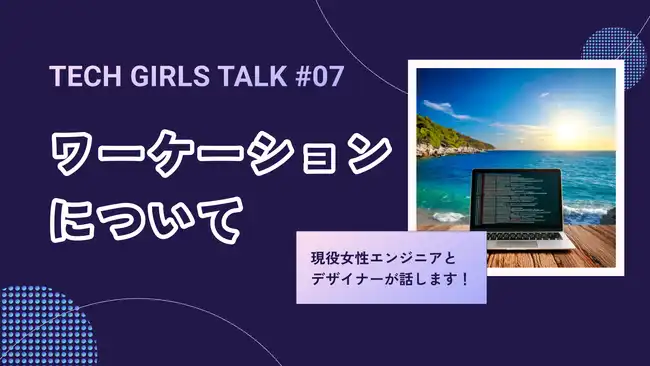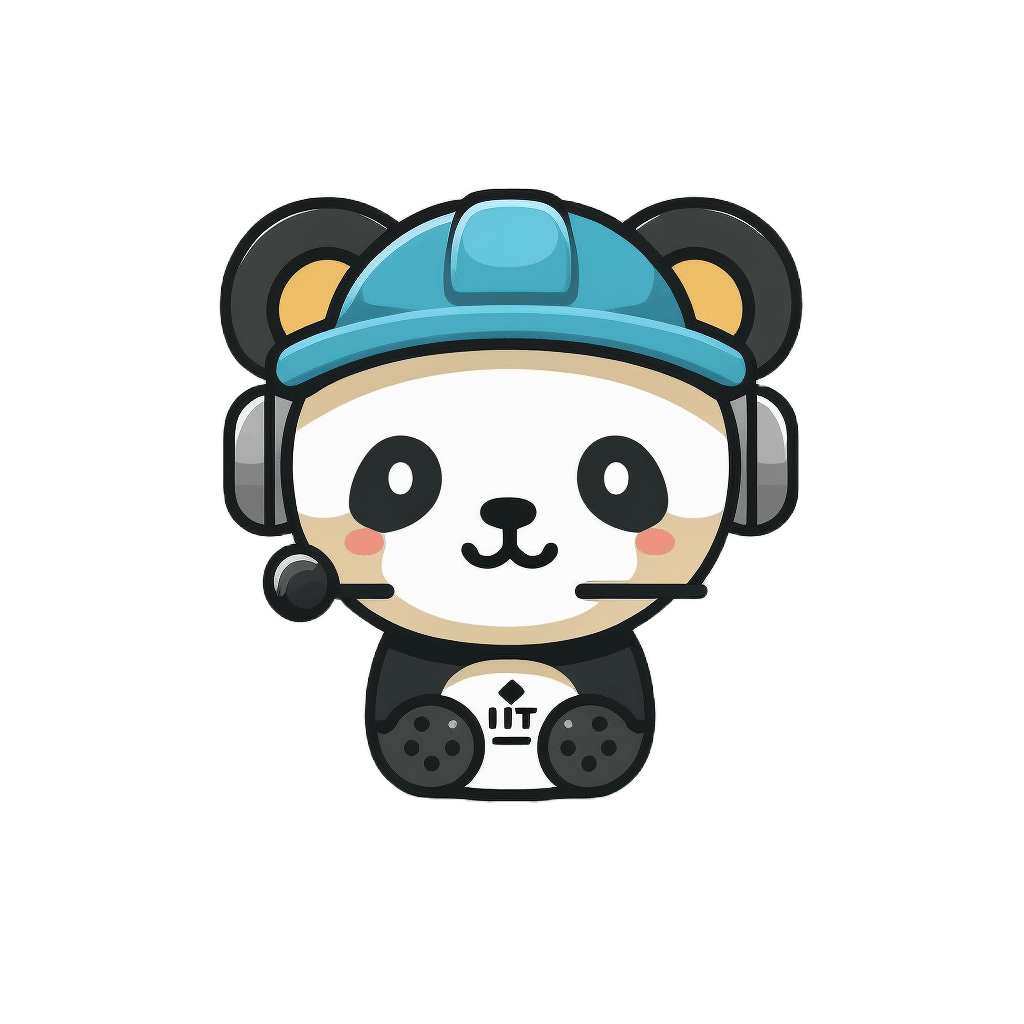About Workcation [TECH GIRLS TALK 7]
The 7th Tech Girls Talk features workcation as its theme. Mari and Sawako discuss the differences between Japanese and international work styles and ideal environments. From the world's top workcation cities to travel mishaps, they explore the appeal and challenges of remote work.
3/20/2025

Japanese and International Workcation Culture
In this episode, we discussed workcation - a term combining "work" and "vacation."
In Western countries, it's considered an individual lifestyle choice. In Japan, however, it has developed as a corporate-led initiative.
Mari and Sawako exchanged opinions on the differences in café culture across countries and what makes an ideal work environment.
One interesting point was the global workcation city ranking. Budapest, Hungary ranked 1st, while Barcelona, Spain came in 2nd.
It was somewhat disappointing that no Japanese cities made the list. We also discussed possible reasons for this.
Travel Mishaps and Ideal Environments
Sawako shared her experience encountering bedbugs at an airport. This is one example of the troubles that can occur while traveling.
We also discussed the challenges of traveling with pets, particularly the quarantine issues for international travel.
Recent research suggests that environments with moderate background noise, like cafés, can enhance creativity. A noise level of about 70dB is considered optimal.
Scientific insights were shared about how changing environments stimulates the brain and improves cognitive function.
Finding Your Own Way of Working
Finally, the two discussed finding a workcation style that suits each individual.
They concluded that both the Western free-style approach and the Japanese corporate event-style workcation have their own merits.
The stimulation that comes from changing your environment is important. So is the balance between work and private life.
We encourage everyone to find a style that works for them.
Reference Links
- How has workcation evolved in Japan?
- Workcation Blurring the Lines Between Home and Away
- 10 Best Workcation Locations
Episode 7 Links
- YouTube: https://www.youtube.com/watch?v=FgR2-srkSqA
- Spotify: https://open.spotify.com/episode/2ARsL8DhZkHY1kJYN1Lk0i?si=2736e5054fac46bc
- Apple Podcasts: https://podcasts.apple.com/us/podcast/%E3%83%AF%E3%83%BC%E3%82%B1%E3%83%BC%E3%82%B7%E3%83%A7%E3%83%B3%E3%81%AB%E3%81%A4%E3%81%84%E3%81%A6/id1794539468?i=1000699891188
YouTube Transcript Summary
0:02: Welcome to Tech Girls Talk. On this radio show, female engineers and designers working at tech companies explain the latest trends in technology and AI news.
0:07: I’m Mari, the designer, and I’m Sawako, the engineer.
0:12: Yes, so this is Episode 7. Thank you for joining us this week.
0:18: Thank you very much.
0:25: It’s pretty similar to last week’s content, isn’t it?
0:32: Yes, this week we’re going to talk about “workation.”
0:37: Workation – it’s a portmanteau combining “work” and “vacation,” isn’t it?
0:43: Exactly, workation. It’s that idea of enjoying a vacation while working—something that only remote work makes possible.
0:49: But last time we focused on remote work, so this time we’re really talking about enjoying work while having fun.
1:01: Right, that’s what we want to discuss.
1:07: Recently, around the end of last year, I had to return to the United States for a while. Of course, I was working remotely, so even on my days off I was still working.
1:13: I was in America, but when I was coming back to Osaka on my flight...
1:20: …just before boarding the plane, you know the benches by the airport?
1:26: Yes, I totally forgot about that, but nowadays more people are traveling overseas, and you might have heard of bed bugs, right? Bed bugs, known in Japanese as “toji-min.”
2:00: They’re becoming a serious problem, not only in Japan but also abroad. When they appear, it’s a big deal. I used to work in a hotel and even trained managers, and when a room had bed bugs, you really had to use special chemicals to eliminate them. You have to block off every room – horizontally, vertically, diagonally – so that the pests don’t spread.
2:08: Once one appears, it’s a huge problem. Since that time, I’ve had plenty of experience with bed bugs. In our hotel, they popped up a few times, but we immediately block off the affected rooms and the surrounding ones so that no one stays there. We deal with them very quickly so that they don’t spread.
2:18: The other day, on the flight home from America, I saw one on an airport bench.
2:25: I was sitting there when one crawled onto my down jacket.
2:31: It looked like a real bed bug – not something you can easily miss with the naked eye. It was quite large, as if it had sucked someone’s blood.
2:38: It was pretty big, and I thought, “Oh no.” Its markings were really distinct, so I Googled it—though if you’re squeamish, you might not want to see those images. I had seen one and immediately panicked.
2:46: At that moment, I was checking some work on my laptop and also enjoying the airport atmosphere like I would at a café, but then it hit me: I had to get all my belongings off that bench.
2:52: It was terrifying. I had to check every seam of my down jacket, in case a bed bug had hitched a ride.
3:03: I even turned all my bags inside out, exposing everything to sunlight—since they’re sensitive to light—and checked every single item.
3:11: I even asked my husband, who was traveling with me, “Check your stuff too – it might be on your jacket!” Both of us went into full panic mode. Then, just at that moment, an old friend from college, whom I hadn’t seen in about 20 years, showed up.
3:18: I apologized, saying, “I’m sorry, I just saw a bed bug.” He reassured me, “It’s alright, don’t worry about it,” though it did spoil the long-awaited reunion a bit.
3:26: We both ended up checking for bed bugs, and thankfully, nothing was found. We were on the same flight, so after I explained what had happened, he even laughed about it.
3:35: It’s one of those things that happens only when you’re super busy. Sometimes, while you’re traveling for work, you unexpectedly run into someone you haven’t seen in a long time.
3:42: That’s one of the fun parts of a workation.
3:47: But you have to be careful. Recently, there have been quite a few of these incidents. I’ve seen news reports saying that places like London and Manchester have been hit pretty hard by bed bugs. Personally, I live in an area closer to the sea – a more laid-back area – so it didn’t affect me as much.
4:03: There was also a lot from France and Italy. It’s quite concerning – if you’re going to travel, be cautious.
4:09: In addition to these bed bug concerns, I found an interesting article that I’d like to share with you.
4:17: This article is from CNBC Make It. It’s titled “Top 10 Workation Cities for Hybrid Workers.” It was released by the International Workplace Group, which provides flexible office spaces.
4:22: The ranking is based on a survey of 1,000 hybrid workers and independent research, evaluating 10 factors: climate, culture, accommodations, transportation, dining, cost of living, happiness, broadband speed, sustainability, and the availability of flexible workspaces.
4:28: The top city is Budapest, Hungary. Budapest scored highly for accommodations, transportation, sustainability, and broadband, plus its classic architecture, abundant green spaces, and charming streets make it very attractive.
4:34: Coming in second is Barcelona, Spain. It has great transportation infrastructure, relatively affordable living costs, and warm weather along with good accommodations.
4:42: Ranking third to tenth are: 3rd - Rio de Janeiro, Brazil 4th - Beijing, China 5th - Lisbon, Portugal 6th - New York, USA 7th - Singapore 8th - Jakarta, Indonesia 9th - Los Angeles, USA 10th - Milan, Italy
4:49: The popularity of workations has really taken off since the onset of the COVID-19 pandemic; remote workers increased fivefold between 2019 and 2023 in the United States. Now, 40% of employees work remotely at least one day a week.
4:55: The appeal of workations is that 84% of hybrid workers consider extending their vacation to work remotely, and 75% believe that the freedom to work from anywhere improves job satisfaction. The CEO of IWG (International Workplace Group) even stated that demand for workations will continue to grow as companies promote better work–life balance.
5:07: Now, many cities are coming into the picture – America, China, Spain, Brazil, etc. It’s a pity that Japan isn’t included.
5:13: It’s a shame because I’m sure Japan has many great locations. Sometimes, when I want a change of pace, I consider working at a café. But, if it’s a big chain like Starbucks or one of those American companies, you can stay without time restrictions. Smaller cafés, however, often have limitations like borrowing power outlets or only allowing internet use for an hour.
5:21: In some places, you even see signs that say “Please vacate after one hour.” Small business cafés are doing their best, but it’s interesting how these differences in café cultures become apparent.
5:27: In Japan, there are many cafés where you can use the Wi-Fi free for one or two hours. I once traveled with my husband to Europe, and I noticed that the café culture there is quite different from what we’re used to in the US and Japan.
5:34: In America, wherever you go, it’s customary to relax and enjoy your coffee slowly. Many cafés are spacious with flexible seating and plenty of outdoor chairs, making them very comfortable places to spend time. People naturally end up ordering something if they’re there for an hour or two.
5:40: In contrast, in parts of Europe like Italy and France, the culture is more about quickly having a shot of coffee at the bar – you drink it quickly, pay a lower price, and then leave. When you sit at a table, there’s usually an extra charge.
5:48: That difference really reflects the local coffee culture. In Japan, I sometimes feel conflicted; I want to relax with a good cup of coffee, but the space is often too small, like in Tokyo cafés.
5:55: In my experience, places in Fukuoka or Okinawa might be more suitable for workations. When planning a workation, if you want to explore a city like Kyoto, you might find that transportation is a bit challenging, as you’d have to walk quite a bit, and sometimes cafés have strict time limits.
6:01: On the other hand, if you go too far out into the countryside, you might have to pay extra to reach tourist attractions.
6:08: It’s interesting that Budapest and Barcelona are both in the top 10; they’re warm cities. Lisbon is also on the list. On the other hand, cities like Beijing or even Tokyo might deserve to be included.
6:15: It’s a bit frustrating because, by price standards, the top three cities tend to be places where the cost of living is higher, partly because of the concentration of amenities and infrastructure.
6:21: For example, in Spain, there are Airbnbs right in front of the Sagrada Familia. I’ve even bookmarked one where you can see the basilica right through the window – it would be amazing to work from there.
6:27: Of course, Japan might have similar spots, but hotels in Japan are generally expensive. Their pricing tends to reflect the high level of service and cleanliness, so it might not be as competitive.
6:32: I remember a university professor once told me when he landed at Haneda (or maybe Narita) that he would gladly lick the floor because it was so clean. That kind of standard really drives up costs.
6:39: It takes extra time and money to maintain such high cleanliness and service levels.
6:45: Speaking of climate, sometimes the weather changes drastically. For digital nomads, a place with a consistently warm climate or mild temperature differences is ideal. European summers, for example, are quite dry and comfortable.
6:53: In contrast, here, during summer, you might need extra sunscreen and sunglasses because of the harsh, direct sunlight, which can be quite jarring.
7:01: I’ve always imagined that digital nomads tend to travel with very small suitcases. In a hot, dry summer, you wouldn’t have to pack many changes of clothes, which is a plus.
7:06: But in any case, each location has its own challenges. For instance, while Hungary, Spain, and Brazil are warm, it’s a bit surprising that New York made the list.
7:12: New York is known to be expensive. However, if you consider the cost per person when sharing a room, sometimes it might be more affordable than you’d expect.
7:18: In New York, you can sometimes rent an entire room for around $100 or $200 a night. In Japan, costs are often calculated per person, which drives the price up.
7:24: On the café market side, I only visited a couple of cafés in New York, but American cafés tend to be relatively affordable and are conducive to work. There are also plenty of parks.
7:31: But New York is known for its chilly winters as well as its hot summers. I remember last year there were times when New York had to cool down drastically—even though it was warm overall.
7:38: I also used to live in Washington State, where I experienced smoky days from wildfires in the mountains for nearly three weeks. In those cases, the constant lower temperatures meant that many apartments didn’t even have central AC, so people had to open windows in summer, even though the air outside wasn’t ideal.
7:46: In Los Angeles, during summer, it can also be challenging. In contrast, areas like Nara in Japan might be more pleasant.
7:53: Japan offers the beauty of cherry blossoms and a comfortable temperature in spring, which makes it possible to work outdoors.
8:01: Spring is a great time for a workation. I suffer from hay fever, but I still think that spring is the perfect season.
8:08: Although we didn’t touch on this in our discussion today, there is a unique way workations are done in Japan. There’s an article that points out how the word “workation” is used differently here compared to the Western usage.
8:16: In Japan, companies often use “workation” as a way to encourage employees to go to regional areas. Typically, employees don’t really want to move far from where they live because they prefer convenience. So, the term “workation” is sometimes used to imply that employees will be “sent” to the countryside—not exactly a vacation, but rather a business trip with a side of relaxation.
8:25: It’s a unique use of the term. In the West, workation means you choose to work while on vacation. In Japan, it can sound more like, “Today you’re going on workation – you’re being dispatched.” It’s a subtle but interesting difference.
8:32: I’ve heard of companies organizing retreats in places like Okinawa for a month-long training session. It’s not exactly a company trip, but rather a workation, where you work while changing your location and refreshing your mind.
8:40: But this is quite different from the typical freelance workation in the West where you simply work and enjoy your vacation afterward.
8:46: In those cases, you often end up being taken out by your boss to dinner or drinks afterwards. It’s more about bonding with your coworkers.
8:53: That said, it’s a way to strengthen the bond between employees. It’s like a company retreat that combines work and leisure.
8:59: Personally, my company only meets once a year, and that single retreat is really something I cherish. It feels like a vacation while still working, and I love it.
9:06: I wonder what everyone else prefers – the Western style workation or Japan’s unique version? Please let us know in the comments. I’m curious about your thoughts. By the way, Mari, which do you prefer?
9:12: I lean toward the Western style because my current work style fits that model. I enjoy going to different places on my own as well as with everyone together at least once a year. It’s best to have both options available.
9:20: Yes, being able to work at a café or try a new location while still enjoying a vacation is ideal. It gives you the freedom to feel like you’re working for yourself rather than solely for the company.
9:26: So please share your thoughts in the comments!
9:32: Thank you everyone for joining us this week. As before, we kept things rather relaxed, so we hope you enjoyed the discussion.
9:38: Thank you very much, and we look forward to next week. This has been Tech Girls Talk Radio. Thank you so much!




